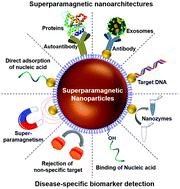当前位置:
X-MOL 学术
›
Chem. Soc. Rev.
›
论文详情
Our official English website, www.x-mol.net, welcomes your
feedback! (Note: you will need to create a separate account there.)
Superparamagnetic nanoarchitectures for disease-specific biomarker detection.
Chemical Society Reviews ( IF 40.4 ) Pub Date : 2019-11-13 , DOI: 10.1039/c9cs00174c Mostafa Kamal Masud 1 , Jongbeom Na , Muhammad Younus , Md Shahriar A Hossain , Yoshio Bando , Muhammad J A Shiddiky , Yusuke Yamauchi
Chemical Society Reviews ( IF 40.4 ) Pub Date : 2019-11-13 , DOI: 10.1039/c9cs00174c Mostafa Kamal Masud 1 , Jongbeom Na , Muhammad Younus , Md Shahriar A Hossain , Yoshio Bando , Muhammad J A Shiddiky , Yusuke Yamauchi
Affiliation

|
The detection of clinically relevant disease-specific biomolecules, including nucleic acids, circulating tumor cells, proteins, antibodies, and extracellular vesicles, has been indispensable to understand their functions in disease diagnosis and prognosis. Therefore, a biosensor for the robust, ultrasensitive, and selective detection of these low-abundant biomolecules in body fluids (blood, urine, and saliva) is emerging in current clinical research. In recent years, nanomaterials, especially superparamagnetic nanomaterials, have played essential roles in biosensing due to their intrinsic magnetic, electrochemical, and optical properties. However, engineered multicomponent magnetic nanoparticle-based current biosensors that offer the advantages of excellent stability in a complex biomatrix; easy and alterable biorecognition of ligands, antibodies, and receptor molecules; and unified point-of-care integration have yet to be achieved. This review introduces the recent advances in superparamagnetic nanostructures for electrochemical and optical biosensing for disease-specific biomarkers. This review emphasizes the synthesis, biofunctionalization, and intrinsic properties of nanomaterials essential for robust, ultrasensitive biosensing. With a particular emphasis on nanostructure-based electrochemical and optical detection of disease-specific biomarkers such as nucleic acids (DNA and RNA), proteins, autoantibodies, and cells, this review also chronicles the needs and challenges of nanoarchitecture-based detection. These summaries provide further insights for researchers to inspire their future work on the development of nanostructures for integrating into biosensing and devices for a broad field of applications in analytical sensing and in clinic.
中文翻译:

用于疾病特异性生物标志物检测的超顺磁性纳米结构。
临床相关疾病特异性生物分子(包括核酸,循环肿瘤细胞,蛋白质,抗体和细胞外囊泡)的检测对于了解其在疾病诊断和预后中的功能是必不可少的。因此,在当前的临床研究中,正在出现一种用于对体液(血液,尿液和唾液)中的这些低丰度生物分子进行可靠,超灵敏和选择性检测的生物传感器。近年来,纳米材料,特别是超顺磁性纳米材料,由于其固有的磁性,电化学和光学特性,在生物传感中起着至关重要的作用。然而,基于多组分磁性纳米粒子的电流生物传感器的工程化设计具有在复杂生物基质中具有出色稳定性的优势。对配体,抗体的生物识别简单易变,和受体分子;和统一的即时医疗点整合尚待实现。这篇综述介绍了用于疾病特定生物标记物的电化学和光学生物传感的超顺磁性纳米结构的最新进展。这篇评论强调了纳米材料的合成,生物功能化和固有特性,这些材料对于鲁棒,超灵敏的生物传感至关重要。特别强调基于纳米结构的疾病特异性生物标记物(例如核酸(DNA和RNA),蛋白质,自身抗体和细胞)的电化学和光学检测,该综述还记载了基于纳米结构的检测的需求和挑战。
更新日期:2019-11-13
中文翻译:

用于疾病特异性生物标志物检测的超顺磁性纳米结构。
临床相关疾病特异性生物分子(包括核酸,循环肿瘤细胞,蛋白质,抗体和细胞外囊泡)的检测对于了解其在疾病诊断和预后中的功能是必不可少的。因此,在当前的临床研究中,正在出现一种用于对体液(血液,尿液和唾液)中的这些低丰度生物分子进行可靠,超灵敏和选择性检测的生物传感器。近年来,纳米材料,特别是超顺磁性纳米材料,由于其固有的磁性,电化学和光学特性,在生物传感中起着至关重要的作用。然而,基于多组分磁性纳米粒子的电流生物传感器的工程化设计具有在复杂生物基质中具有出色稳定性的优势。对配体,抗体的生物识别简单易变,和受体分子;和统一的即时医疗点整合尚待实现。这篇综述介绍了用于疾病特定生物标记物的电化学和光学生物传感的超顺磁性纳米结构的最新进展。这篇评论强调了纳米材料的合成,生物功能化和固有特性,这些材料对于鲁棒,超灵敏的生物传感至关重要。特别强调基于纳米结构的疾病特异性生物标记物(例如核酸(DNA和RNA),蛋白质,自身抗体和细胞)的电化学和光学检测,该综述还记载了基于纳米结构的检测的需求和挑战。











































 京公网安备 11010802027423号
京公网安备 11010802027423号